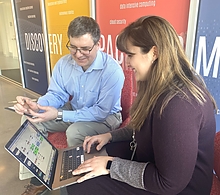Pop Receives $2.6M NIH Grant to Develop Computational Tools for Metagenomic Analyses

Mihai Pop, a professor of computer science and director of the University of Maryland Institute for Advanced Computer Studies (UMIACS), was recently awarded a $2.6 million federal grant to develop a suite of computational tools for reconstructing DNA segments.
The four-year award comes from the National Institute of Allergy and Infectious Diseases, which is part of the National Institutes of Health. The money supports efforts to build software and develop algorithms that can reconstruct nearly-complete microbial genomes from complex mixtures found in environments like the human gut. Ultimately, researchers say, this will help scientists better understand the role that certain microbes have in human health and disease.
Pop (left in photo) is principal investigator of the project, and will be assisted by postdocs and graduate students in the Center for Bioinformatics and Computational Biology (CBCB), as well as software experts in the Fraunhofer USA Center for Experimental Software Engineering.
“We want our software to be well-written and usable by biologists across many different computing platforms, so Fraunhofer will help us greatly with that software engineering aspect,” Pop says.
Recent years have seen a “metagenomic revolution” made possible by rapid advances in sequencing technologies, explains Pop. Metagenomics involves the application of bioinformatics tools to study the genetic material from environmental, uncultured microorganisms.
To date, hundreds and possibly thousands of microbial communities have been characterized through deep sequencing, complementing the wealth of data that has already been generated through the targeted sequencing of individual genes.
These studies have started to shed light on the broad functional potential of microbial communities, Pop adds, even though the individual microbes cannot be easily isolated and analyzed in the laboratory.
But despite these advances, relatively few genome sequences have been generated through metagenomic methods. Even those sequences have had a limited impact on the scientific community due to concerns about the quality of reconstruction and inability to assign taxonomic labels to sequences not derived from isolated genomes.
“We want to better understand processes that usually can’t be seen until the bacteria is isolated,” Pop says. For example, he asks, “What if you have two different strains of E.coli in your gut, what is the difference between them, and why does that variance matter?”
In some of the samples his group has been looking at, certain bacteria have acquired antibiotic-resistance genes. This can turn some bacteria into harmful entities, even though they normally wouldn’t be. The software suite Pop’s team is developing will hopefully offer insight into this phenomenon.
“Just being able to generate more data to better understand how bacteria react to each other is a large part of the project,” says Jaquelyn Meisel (right in photo), a postdoctoral associate in CBCB.
“We might be able to identify that this patient has a resistant bacterium that came from some other bacteria that the patient has, or maybe it’s environmental,” Meisel explains. “Once you’re able to track variance, you might be able to say, ‘well I saw this variance somewhere else and now I see it here.’”
Looking ahead, Pop and his team see their work as an important step in helping other scientists and clinicians determine how both good and bad bacteria move through environments, inside and outside of the human body.
“In a cultural context, we want to know when antibiotic-resistant genes get into the food stream,” Pop says. “We know that if you feed animals antibiotics, eventually you see the same bacterium in humans with that resistance. But we don’t have a very clear path of transmission. These tools will hopefully start developing that chain of transmission.”
—Story by Maria Herd
